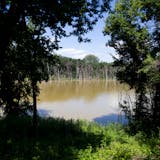When Swedish immigrant Carolyn Hjelmerus came to Minneapolis in 1889, she brought with her a bobbin lace sample book.
More than 130 years later, Minneapolis artist Amy Sands discovered excerpts from the book in the American Swedish Institute's online archives. Locked out of the museum by the pandemic, Sands continued investigating online and through Zoom sessions with ASI staff, who located the book and sent the artist a digital copy.
These and other assorted pandemic-induced twists and turns led to "Lace Reimagined," an exhibit now on display at the Swedish Institute. The Brainerd-born artist didn't actually see the real-life sample book — which is included in the show — until the day in February that she delivered her work to the museum.
"I felt connected to making this series during the pandemic," said Sands. "That isolation felt similar to the way women worked during those times, often only having a small sample as their guide, and no instruction or diagram."
Sands, who is of Norwegian and Swedish heritage, creates one-of-a-kind paper and digital prints. She also worked with the Minnesota Lace Society to collect more research on bobbin lace, also known as "pillow lace," which is created by braiding and twisting lengths of thread on bobbins.
"Lace Reimagined," displayed in the hallway connecting ASI's old Turnblad Mansion with its modern Nelson Cultural Center, includes seven digital engravings on acrylic, three papercut/serigraphs, and seven hand-colored serigraphs that utilize lace patterns.
Another large-scale piece hangs outside on the fence facing Park Avenue, bringing lace designs into a space where traditional lace could never exist.
In Sands' world, lace is no longer something to sew on a dress or pin to a tablecloth. It's another means of creating an aesthetic experience.



